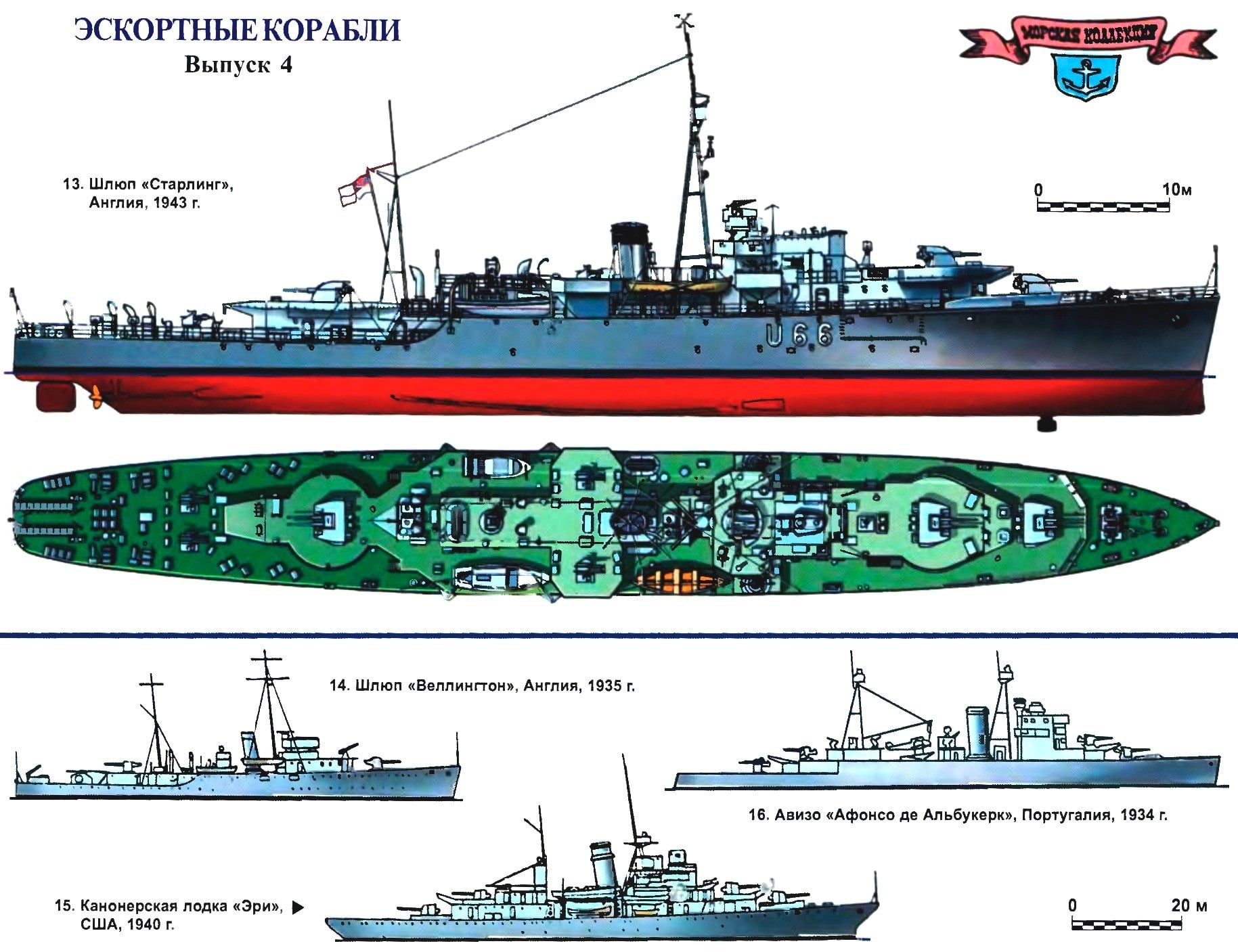 By the end of the First world war the British Navy had a fair amount of patrol type “flower”, but at the end of the 1920-ies it became clear that these hastily built ships will be developed very quickly. Therefore, the renewal of the composition of forces escort and protection, the British started ahead of time.
By the end of the First world war the British Navy had a fair amount of patrol type “flower”, but at the end of the 1920-ies it became clear that these hastily built ships will be developed very quickly. Therefore, the renewal of the composition of forces escort and protection, the British started ahead of time.
The first sloops of the new generation, “Bridgwater” and “Sandwich” — characteristics very reminiscent of its predecessors (1050 tonnes, 16.5 per node two 102-mm guns and depth charges) but had a more modern silhouette and improved contours. It was envisaged that these will be used primarily as high-speed minesweepers. Like the project, and within three years, from 1929 to 1932, stocks fell another 16 units differs little from the prototype (latest 12 had extended approximately 5.5 m shell). Another, “Hindustan”, was intended as the flagship of the Indian colonial fleet. He got the equipment for service in the tropics and was longer by 5 m.
Starting with the next episode (“Grimsby”) changes the main purpose of the sloops. Now it was supposed to use them mainly for escort duty in the ocean. Increased caliber artillery, there was 76-mm antiaircraft gun, increased fuel capacity. The new court has received the metropolis, Australia and one in India.
Sloops of this type are well suited for anti-submarine warfare and surface “trifle”, but was virtually defenseless against a new opponent. Since the early 1930-ies the main danger from “above” was considered a medium bomber, developed on the basis of the “Bridgewater” the following projects of escort ships, the emphasis was on the power of artillery. The sloops of the “Bittern” (so called this series, although the head guard almost immediately was renamed “Enchan-tress”) had three twin installation of the 102-mm universal guns — more than I could “put” on Board a standard cruiser. To reduce the harmful effects of pitching on the accuracy of fire, the ships are equipped with stabilizers. Speed has also increased to almost 19 knots.
According to the drawings of the first “Bittern” in 1936 established two units. Because “firstborn” had already received a new name and a new purpose, becoming a yacht of the Admiralty (somewhat strange use of valuable combat vessel during the period when the threat of war became more and more real!), the vacant title was awarded the second ship — in fact, he has become a leading representative of a new subclass of the patrol. Well, the top ideas of the anti-aircraft ship to protect against horizontal bombers can be considered the following three sloop, laid down in 1937. “Egret”, “Pelican” and “Oakland” has carried four of Sparky and could reach a speed of 19.5 knot. In a cruel twist of fate, “Egret” in August 1943 in the Bay of Biscay fell victim to just high-altitude aircraft, which, however, is understandable: he was struck by a guided gliding bomb Hs-293 — the latest German weapons against which even failed to create “antidote”.
It should be noted that against the main threat from the air, even heavily armed “Egret”, in General, was not too secure. Dive bomber moved vertically too fast to have time to aim and release it more than one or two shells per gun. So the next series of “black Swan” (Black Swan) one of the 102-mm Sparky gave way to four 40-mm automatic “POM-POM”, who for all his faults for a long time remained the most effective weapon against dive bombers from among the available Royal Navy. Interestingly, both survivors of 1941 “8-gun” sloop lost one Sparky in favor of the “POM-POM”.
Unequivocally considered one of the best escort ships for action in the face of strong opposition from the air, the sloops of the “black Swan” in a modified version continued to build during the war years. The width of the body increased by 30 cm (this made the vehicle more stable), established modern radar equipment, increased light anti-aircraft armament. Some units now had a couple of chetyrehstennoy instead of one other in addition to the regular “POM-pomu” (and sometimes instead of) carrying a few single or paired “bavorov” of the same caliber. A useful addition to steel and 20-mm “erlikon”, whose number reached six ships with “bothersome” and up to a dozen those who last had. Stock depth charges, and so very solid (110 pieces), could be increased in the half due to the reduction of ammunition, light anti-aircraft guns. In addition to the usual mortars and release gear on the deck there was, though with difficulty, a place for reactive mortars “Hedgehog”.
All the years of the war begun operation on 29 patrol, not counting the four specially built for the Indian Navy. It should be noted that ships built before the war were also undergoing modernization, which has increased the number of anti-aircraft guns, and a supply of depth charges.
Escort patrol of both types, anti-submarine and anti-aircraft, during the Second world war proved to be very popular. 52 they sank enemy submarines (although mostly in conjunction with vessels of other types). 12 sloops were killed in the fighting with the underwater and air enemy, “Yarra” sank in battle with two Japanese heavy cruisers, protecting the convoy off the coast of Java, and the other two were so badly damaged as a result of falling torpedoes that could not be restored.
After the war service of the surviving ships continued. Ironically, “Action”, “Flamingo”, “HART” and “Mermaid” in the late 1950-ies was in the German Navy — the truth, now called Bundesmarine and became a strategic ally of the British fleet. They received the proud names once their on the sides of battleships and cruisers: “Hip feathers”, “Graf Spee”, “Scheer” and “Scharnhorst”. Much rebuilt the “Scharnhorst” will serve the new owners for a very long time — it passed for scrapping in 1990. Until the mid 80-ies continued to stay afloat and also four of the Indian sloop.
The secret of success of British designers-shipbuilders consisted primarily in the fact that they have shown commendable moderation: their patrol had a reasonable performance, not claiming to be the prize in the struggle for the most powerful (and also expensive) ship. Different concept chose them “transatlantic cousins”, persistently rushing toward the world championship on the seas. Admirals of the United States of America preferred to have the major combat units in all classrooms. No exception, and court escorts.

13. The sloop “Starling”, England, 1943
One of a series of ships of the “black Swan”, built by “the Fairfield”. Displacement 1350 tons standard, full 1880 T. maximum Length 91,29 m, width of 11.73 m, draft 3,45 m. Capacity twin-shaft steam turbine 4300 HP, speed 19.75 node. Armament: six 102-mm guns, ten 20-mm guns. Just 1939-1946. total of 38 units.
14. Sloop Wellington, England, 1935
One of the ships of type “Grimsby”, built at the shipyard of the Navy in Devonport. The standard displacement of 1000 tons, 1,500 tons of full Length most 81,15 m, width 10,97 m, draught of 3.05 m. Capacity twin-shaft turbine plant of 2000 HP., speed 16.5 per node. Armament: two 120 mm and one 76-mm gun. Just 1935-1940 built 14 units, including four to Australia and one (“Indian”) — for India. All Australian ships and the English “Aberdeen” had weapons of three 102-mm guns, “Fleetwood” was carrying two Sparky the same guns.
15. The gunboat “Erie”, USA, 1940
Built at the shipyard of the Navy in new York. The standard displacement of 2000 tons, normal 2340, 2800, etc full Length the greatest 100,13 m, width of 12.57 m, draft 3,45 m. Capacity twin-shaft steam turbine 6200 p. C., speed 20 knots. Armament: four 152-mm guns, four 4-scopinich 28 mm assault rifles. Just built two units: “Erie” and “Charleston”.
16. Aviso “Afonso de Albuquerque”, Portugal, 1934
Built in England by the firm “Hawthorne Leslie.” The standard displacement of 1780 tons, full 2440 T. maximum Length 99,6 m, width 13,49 m, draft 3,83 m. Capacity twin-shaft steam turbine 8000 HP, speed 21 knots. Armament: four 120-mm and two 76-mm guns, four 40-mm machine gun, two mortars, 40 min seaplane. Only in 1934-1935 built two units: “Afonso de Albuquerque” and “Bartolomeu Dias”. The first of them is sunk by the Indian Navy in 1961, the second excluded from the lists of the fleet in 1965
For the love of gigantism, the Americans decided to create the “sloops” the maximum tonnage allowed under the London naval agreement. This Treaty, signed in 1930, all major Maritime powers, not restrict neither the number nor the total displacement of warships of up to 2000 tonnes at a maximum speed of 20 knots, armed with guns of a caliber of 155 mm. Issued to engineers the task is formulated simply: squeeze everything you can out of contractual limitations, using the maximum parameters.
Thus was born the project “Erie”, to the maximum extent close to the cruiser. Four powerful six-inch guns of the newest model, which took charge in the sleeve and a very high rate of fire, firepower commensurate with the side salvo of the cruiser during the First world war. Americans care about anti-aircraft weapons: it consisted of four “the Chicago piano” — a new four-28-mm anti-aircraft machine guns. In addition to the artillery there were the seaplane, which could be used for reconnaissance and to adjust fire. The ship even managed to book: belt in the area of cars had a thickness of 88-51 mm, and on the top it was covered with armor deck 25-37 mm. After installation of appropriate equipment this boat-boat-cruiser has become more and minelayer.
Had to find a proper role for such an impressive fighting unit. It was assumed that “Erie” will be able to defend the convoy from attack by auxiliary cruisers of the enemy, which could carry guns of the same caliber, but conceded a specialized ship in the fire control system. Patrol and anti-submarine service stood in second place. Finally, the new type is perfectly suited as a “small batons of uncle Sam”. Having a shallow draught and fairly extensive interior, it was fit for landing of small landings on the coast of the shrew neighbors from Central America.
Conflicting demands caused by a variety of possible tasks, encouraged the designers to exercise a fair amount of engineering tricks. To increase seaworthiness enclosure equipped extended kleparski nose, while the feed had a significant overhang for the convenience of dumping depth charges or mines. Pretty massive command-ranging post and tips the mast seemed to have migrated from modern heavy cruisers, gunboats has taken a very original view, which they can hardly be mistaken for any other warship.
In General, the “Erie” and “Charleston” were all good except the cost. Versatile, powerful, carefully designed, they are clearly not suited for mass production on a small and poorly equipped shipyards in the war years. So when a few years, the United States filled all of the sea patrol and konvoinyi ships of the new series, they already bore little resemblance to its predecessors “maximalist” concept.
Of course, such a different approach leading Maritime powers to escort the ships decent sowed confusion in the minds of the naval leaders of the States “second grade”. However, sometimes the initial borrowing ideas from the powerful led in the end to very interesting results.
An example is Portugal. Empire, the owner of the colonies, which by population and area in relation to the mother country hardly inferior to, say, the Empire of the descendants of the Gauls, had all the same problems the Navy. And she needed quite strong and large, but, however, cheap versatile ships for service in the overseas possessions.
It all started in 1931 when the British firm “Hawthorne Leslie” received an order for a couple of sloops, similar to “Bridgewater”. While the Portuguese contributed to the project requirements some important additions. Weapons became more powerful and consisted of three 120-mm guns, four 40-mm guns and the same number of mortars, and the cruising range has increased markedly due to the increased fuel supply. In the end, got like twice the copy of the French “Bougainville”, although in accordance with the English prototype of the power plant the, turbine.
The sloops made a favorable impression, and was followed by the decision to order two more powerful ships of the same class. Initially the contractor chose the Italian firm, but due to the traditionally strong influence of the British in Portugal, and the order was transferred to the same plant “Hawthorne Leslie.” “Afonso de Albuquerque” surpassed its predecessors on all counts, especially the armament and speed. Compare it with the “Bougainville” shows that, apparently, at that time the project of the universal ship, a kind of colonial “semi-cruisers”, was quite distinct features. Although the Portuguese option instead of diesel engines continued to be used for the turbine, otherwise both ships roughly equivalent in strength and are comparable in other characteristics.
Along with orders from the “big brother” your strength was tested and the national shipbuilding industry. Diesel memos, “Nunes” and “Lisboa,” designed by Portuguese engineers and built entirely at home, had the original flush-deck hull. “Ha Tarnowski” ships of the first series they were somewhat inferior in force of arms, as he carried one 120-mm gun less. But overall the project was successful, and the “Nunes” has set a record of longevity among the Portuguese fighting ships of interwar building, having served for over 40 years.
V. KOFMAN



